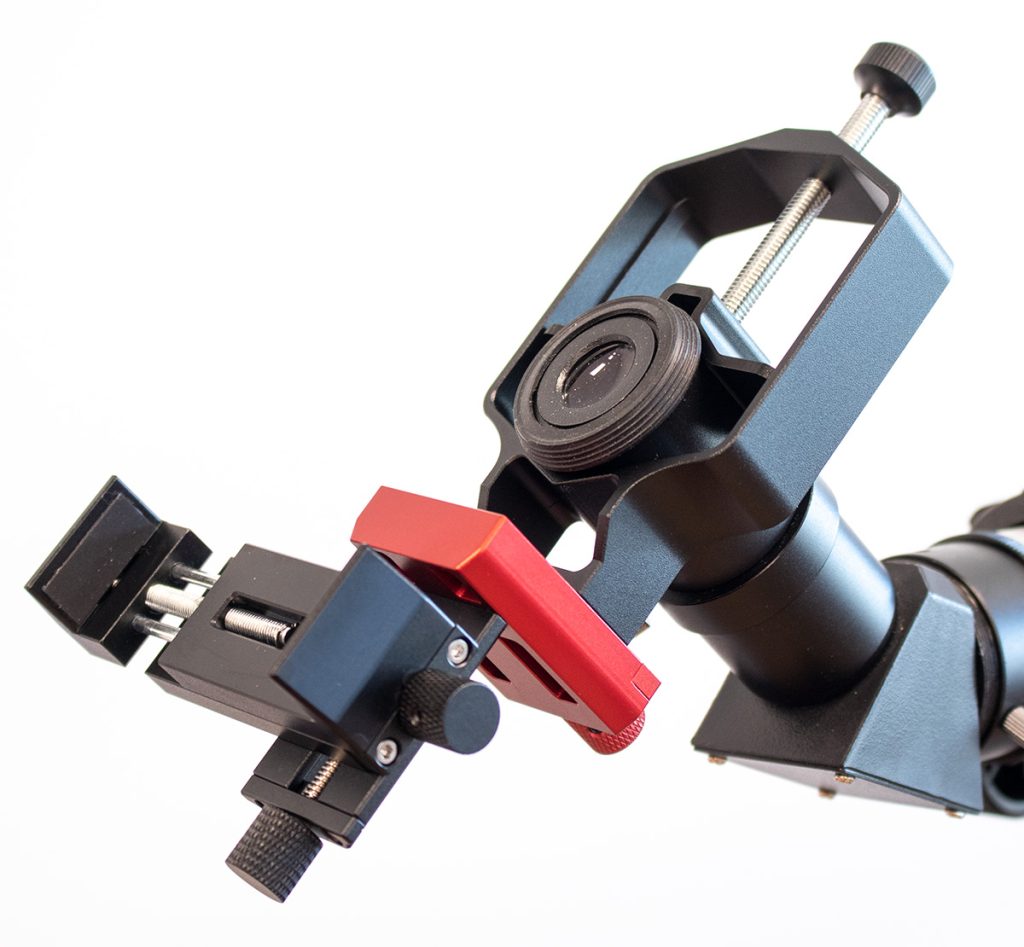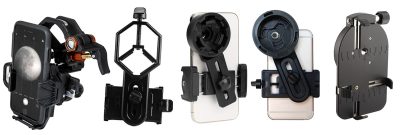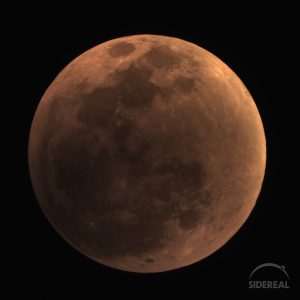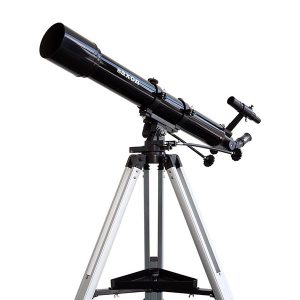Recently, we received a shipment of the Move-Shoot-Move Tridapter phone adapter. A phone adapter is simply a clamp that grips the eyepiece of your telescope (or maybe the end of the focus tube if you have a very short lens) and also grips your phone. This provides a way of positioning your phone so that its camera lens “looks” straight into the eyepiece of the telescope. There’s nothing revolutionary about the concept.
Just another phone adapter?
Phone adapters like this are quite common items, and just about everyone makes one. The unusual thing here, though, is that there’s not a lot of rebadging going on. Rather than having the same product branded a half dozen times, there really are different products. And of course, different designs have advantages and disadvantages.
So, what we have to do is figure out what boxes the different designs have to tick. Only then can we start to assess which phone adapters tick those boxes. With a bit of thought, I came up with a number of attributes that are important to the performance of phone holders.
Note that for this review I’m restricting myself to talking about the standard Move-Shoot-Move model. I could talk about other brands but that would make this review too long.
Construction
What the phone holder is made of is going to affect not only its price, but also its longevity and quality. Plastic is by definition flexible (after all, that’s what “plastic” means), and this means it can wiggle and move about on the telescope. Plastic is also easily broken (I don’t want to name names but know someone who broke one in under a week).
The MSM Tridaptor is a simple, all-aluminium design, and the red central part is made of CNC aluminium, meaning it provides a good foundation for the other metal parts. The screw adjustments are smooth and secure, and it doesn’t warp or change shape.
Distance to the eyepiece
All phone holders adjust left-right and up-down, so your camera lens will be adjacent to the eyepiece. One of the more common shortcomings of these gadgets is their inability to adjust the distance from your eyepiece to the phone camera. Not being able to get closer to or further from the eyepiece means the image you get on your phone isn’t as large as it can be. Phone cameras are very (very) wide angle, so when it’s zoomed out, the phone image will always be larger than the image provided by the eyepiece. That is, you’ll see a circular image, and outside of that you’ll see the outside of the eyepiece, or even your hand. Of course, you simply pinch and zoom on your phone, and you’ll get a nice image across the whole of your phone.
The Tridaptor is one of only two phone holders I know of that adjust in and out. This means you can optimise the placement of your camera, exploiting whatever eye relief (and possibly apparent field of view) it provides.
Gripping stability
Speaking of moving about, how the holder grips your telescope’s eyepiece matters. In general, phone holders either grip the front of the eyepiece using a spiral clamp, or they use a clamp that’s more like a woodworking vice. One brand grips the eyepiece from the side, a little like a pair of scissors.
Of course, the shape and construction of the eyepiece you attach it to matters a lot. For example, the Tridaptor won’t go on the Sky-Watcher 28mm LET 2″ eyepiece because the eyepiece itself is too wide. There is a larger version of the phone holder available if you have very large eyepieces. Eyepieces with plastic knurled grips around them can also mean the Tridaptor can wiggle around a little. Clearly, choosing the right eyepiece for this is important.
Ease of setup
Most often, you’ll be attaching your phone to your telescope in the dark. This can be a pain, and it’s only more complicated if you’re wearing gloves on a cold night.
I’ve never found any phone holder entirely easy to set up, but the adjustment screws on the Tridaptor are placed so it’s not too difficult to fumble your way through attaching your phone to the holder and the holder to the eyepiece. The distance adjusting screw is at the back of the Tridaptor, and that’s a little hard to find, especially if you are wearing gloves. Getting a physically short eyepiece into the vice is a bit tricky, and it’s easiest to do that before you put the eyepiece into the telescope.
Drooping when attached
The other most common problem with phone holders is that they don’t clamp the eyepiece securely, and as a result, the phone droops which means the image gets munged. If you want a good image, the phone has to be exactly perpendicular to the optical axis of the eyepiece.
The shape and size of the eyepiece is important here. Getting a flat and parallel part of the eyepiece into the jaws of the Tridaptor will give you a really good firm and perpendicular arrangement. It doesn’t move when you change the position of the telescope.
I have found that the most common 3-D adjusting holder is nearly all there, but it can’t clamp the lens securely enough. I’m not sure if that’s because of the side-grip design, or an asymmetry in weight, but I haven’t had a lot of success with that one.
Weight
In general, phone holders are small and light, especially the plastic ones. I found that weight is less important than the holder’s ability to resist flexing, although there is a point at which a heavy phone and holder will start to stress a light mount.
The Tridaptor is nearly the top weight in the ones we have played with, but it didn’t shift the mount any. If the focuser was racked out so we could focus on something close up, it did cause some flop in the focuser mechanism.
Clickers
Finally, some phone holders (including the Tridaptor) come with Bluetooth “clickers” that mean you don’t have to touch your phone to get the shot. This is really useful because touching your screen to set off the exposure shakes the camera. This ruins the shot every time!
 A couple of tests
A couple of tests
We tested it with my phone on a number of eyepieces we had in stock, and in general, we found it gave good results for eyepieces in the 15-25mm range. Shorter focal length eyepieces tended to cast only a small circular image on the phone. We needed to zoom in on the phone quite a lot, and this led to a loss of resolution. Clearly, the less you have to zoom in the better, but this is more to do with the combination of phone and eyepiece rather than the holder.
We did find a large range of performance across eyepieces, and performance didn’t really correlate with the quality (or price) of the eyepiece.
The eye relief of the eyepiece is significant. The longer eye relief the eyepiece provides, the further the camera can be back from the eyepiece. If you don’t have the camera close enough to the eyepiece you won’t get as wide a field as possible. Too close doesn’t seem to make a significant difference.
The best performing eyepiece on my phone was the saxon Cielo 25mm. Not only was this a comfortable focal length, its field of view covered most of my camera sensor. Because the eyepiece has a plastic knurling around the top there was a small amount of wiggle room, but the Tridaptor held well because the barrel is a cylinder rather than rounded.
The Sky-Watcher LE 15mm was also a good match, although 15mm gave a fraction too much magnification for our tests during the day. The barrel of the eyepiece is partly rounded, which meant that options for where the Tridapter was able to grip were limited.
Very wide apparent field of view eyepieces, such as the Celestron Luminos 10mm, did give us a few problems with the dreaded “kidney bean of death”, where black shadows appeared in the image. These show up if your camera lens is off-axis, even slightly. I suspect it may be more due to the short focal length than the field of view.
Funnily enough, kit lenses work quite well with phones, and they attach firmly because their tubes are parallel. The generic 25mm Plössl gave a reasonable image.
So where does all this get us to?
So, if you’re after some worthwhile images, particularly Lunar images, the Move-Shoot-Move Tridaptor is an excellent choice. It is fully adjustable, and because of its design as well as its all-metal construction, it grips the eyepiece firmly and doesn’t move around. You will probably have to try a few different eyepieces to get the one that works the best though.




